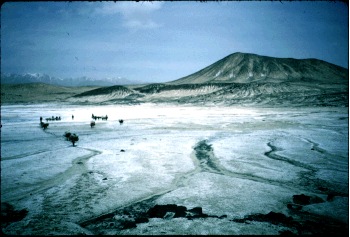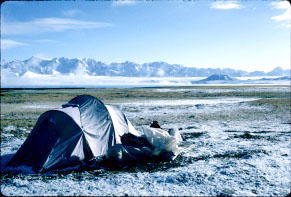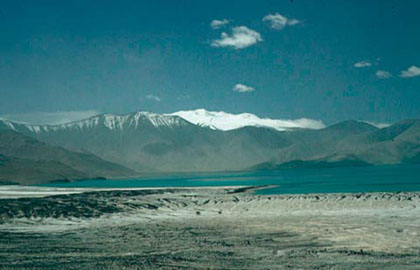
Uplift of the Tibetan Plateau: Insights from cosmogenic exposure ages of young lava flows
On This Page



The Tibetan plateau is a product of the most dramatic tectonic event of recent geological history: the collision of the Indian sub-continent with Eurasia. In spite of the topographic and tectonic implications of the plateau, the mechanisms for its uplift remain controversial. The controversy is in large part a result of poorly constrained uplift history. Types of evidence that have been adduced for the uplift history include paleoecological date, cooling histories of plutonic and igneous rocks, and geomorphic interpretations. Some lines of evidence indicate relatively gradual uplift since the mid-Tertiary, while others support rapid acceleration of uplift during the latest Cenozoic, with the greatest portion during the Quaternary.
In order to address this problem, we have planned a new approach to determining uplift rate of the plateau. Production of cosmogenic radionuclides is strongly a function of elevation. If the Tibetan plateau did experience rapid Quaternary uplift, then early to mid-Quaternary volcanics would have been erupted at significantly lower elevations than those at which they are now found. As a result, they would contain lower concentrations of cosmogenic nuclides than if the plateau were stable, since at the time of eruption they would have been shielded from the cosmic rays by a greater depth of atmosphere. By measuring the cosmogenic nuclide "deficit" wer can calculate the uplift rate.
Field work in the Ashik-kohl basin of the Tibetan plateau, sorth of the Kun Lun Mountains of nouthern Tibet, was carried out in the summer of 1993. Twelve individual lava flows from 6 separate volcanic centers were sampled, along with 4 petrologically interesting rhyolitic lava domes. Good surface features were preserved on the surface of many of these lava flows, allowing geomorphically-meaningful samples to be collected for Cl-36 analysis. The lava flows are of trachyandesitic to basaltic-trachyandesitic composition, and contain phenocrysts suitable for Ar-40/Ar-39 dating. The ages of mafic lava flows range between 70,000 and 300,000 yrs, whereas the domes are slightly older, between 400,000 and 500,000 yrs. The rhyolite and trachyandesitic lavas are clearly genetically related, based on major and trace element geochemisty. Analysis to determine the apparent Cl-36 age and therefore the cosmogenic nuclide "deficit" are underway.
References
- COOPER, K., M. REID, N. W. DUNBAR, W. C. MCINTOSH, and F. M. PHILLIPS, 1996, 238U/236Th disequilibrium in Quaternary volcanic rocks from the Ashikule Basin, Northwestern Tibetan Plateau: EOS, Transactions of the American Geophysical Union, v. 77, p. F790.
- DUNBAR, N. W., W. C. MCINTOSH, and F. M. PHILLIPS, 1996, Field relationships, chronology and petrology of a volcanic system in the northern Tibetan plateau: EOS, Transactions of the American Geophysical Union, v. 77, p. S292.


